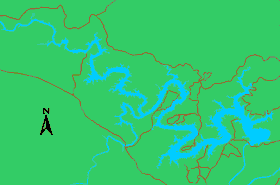Fishing
- Texas Reservoir Levels
- US Army Corps of Engineers
- Texas Water Issues
- Golden Alga
- Aquatic Vegetation
Water Resources
505 Staples Road
San Marcos, Texas 78666
(512) 353-0072
Patrick Ireland, Biologist
Local Information
- LCRA Parks & Recreation Areas
- Lake Travis Chamber of Commerce
- Burnet Chamber of Commerce
- Austin Chamber of Commerce
Nearby State Parks
Lake Travis
Quick Links: Fishing Regulations | Angling Opportunities | Cover & Structure | Tips & Tactics
BOATER ADVISORY: Zebra mussels have invaded this reservoir! CLEAN, DRAIN AND DRY your boat, trailer, livewells/bait buckets, and other gear before traveling to another water body. Draining water is required by law and possession and transport of zebra mussels is illegal.
Lake Characteristics
Location: On the Colorado River northwest
of Austin in Travis and Burnet counties
Surface area: 18,622 acres
Maximum depth: 190 feet
Impounded: 1942
Water Conditions
Current Lake Level
Conservation Pool Elevation: 681 ft. msl, but lake is usually below this level
Fluctuation: High, 10-20 feet
Normal Clarity: Clear to slightly
off-color in upper sections
Reservoir Controlling Authority
Lower Colorado
River Authority
3700 Lake Austin Blvd.
Austin, Texas 78703
(512) 473-3200 or 1(800) 776-5272
Aquatic Vegetation
No significant aquatic vegetation present
Predominant Fish Species
Lake Records
Current
Fishing Report
Stocking History
Latest Survey Report
Lake Maps
Free, downloadable maps of the lake and surrounding areas are available in the map section of the LCRA website. Commercial maps are available at area map, tackle, and sporting goods stores. Lighted mile marker buoys are in place to aid boaters in navigation.
Fishing Regulations
All species are currently managed under statewide regulations. Bow fishers on this lake are subject to special regulations enforced by the LCRA.
Angling Opportunities
Lake Travis is noted for producing good numbers of largemouth bass, although they tend to run small. Very few trophy largemouth bass have been caught. White bass runs occur in the spring (February-May) in the major creek arms, the Pedernales River and the upper end of the Colorado River arm. A low-density striped bass fishery is available in the extreme lower end of the reservoir. Blue, channel, and flathead catfish occur throughout the reservoir.
| Species | Poor | Fair | Good | Excellent |
|---|---|---|---|---|
| Largemouth & Guadalupe Bass | ||||
| Catfish | ||||
| Crappie | ||||
| White Bass | ||||
| Striped Bass | ||||
| Sunfish |
Fishing Cover/Structure
Lake Travis is dominated by rocky banks, steep cliffs, and clear water typical of a highland reservoir. The water tends to become more stained as one moves up the lake, with some portions of the upper end more closely resembling a flatland type impoundment. In the lower end of the reservoir, marinas, floating boat docks, rockpiles, ledges, and steep drop-offs provide cover for game fish. When the water is high, largemouth bass anglers should concentrate on the flooded terrestrial vegetation that lines the banks. The upper end of the reservoir will have more flooded vegetation. Many large creeks enter the lake and hold game fish year round.
Tips & Tactics
Largemouth bass anglers have their best success on this reservoir during
the spring and fall months. Bass fishing from June through August can be difficult
for even the most experienced anglers. Topwater baits such as Zara Spooks,
Jumping Minnows, Pop-R's, and suspended jerkbaits are popular with bass anglers.
Double willowleaf spinnerbaits with metal flake blades also work well. In Lake
Travis, largemouth bass are famous for suspending over points and along drop-offs. Often a topwater, jerkbait, or spinnerbait pulled
near the surface will call them to the top. During the spring, sight fishing
for spawning bass is popular among anglers. A jerkbait pulled along the shoreline
this time of the year will catch some of the bigger female bass that are waiting
to go on the nest. In fall, a big topwater worked on windy main-lake points
can be deadly for both numbers and quality-sized largemouth bass. For live-bait
fishing, try minnows suspended under corks in the same places where an artificial
would work.
For white and striped bass, fishing at night around the lighted boat docks in
the lower end of the lake has become popular during winter months. White
bass start
to run up the major creek arms and into the Pedernales River on their annual
spawning run starting in late February or early March. They may stay in these
areas until May as they slowly trickle back to the main lake. Anglers can catch
these fish using small spinners, jigs, and crankbaits. Striped bass anglers
should concentrate their efforts in the lower lake from the dam to the mouth
of Sandy Creek. In April and May, these fish often school to chase shad and can
be caught using a topwater bait. During the summer, downrigging with bucktail
jigs and trailers over submerged humps and deepwater points is often effective.
Blue catfish dominate the catfish population, but anglers can also find channel and flathead catfish. Stinkbait and cutbait
work well
for the blues and channels, while live bait is preferred for large flathead catfish.
